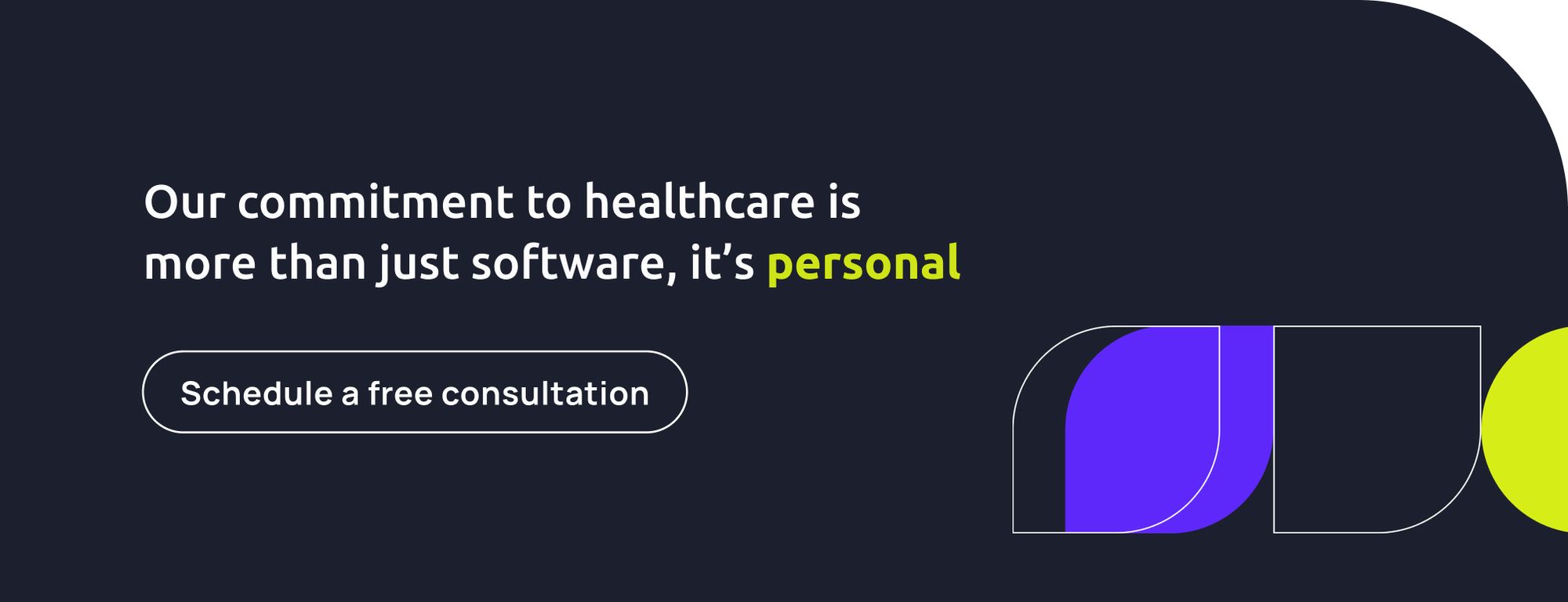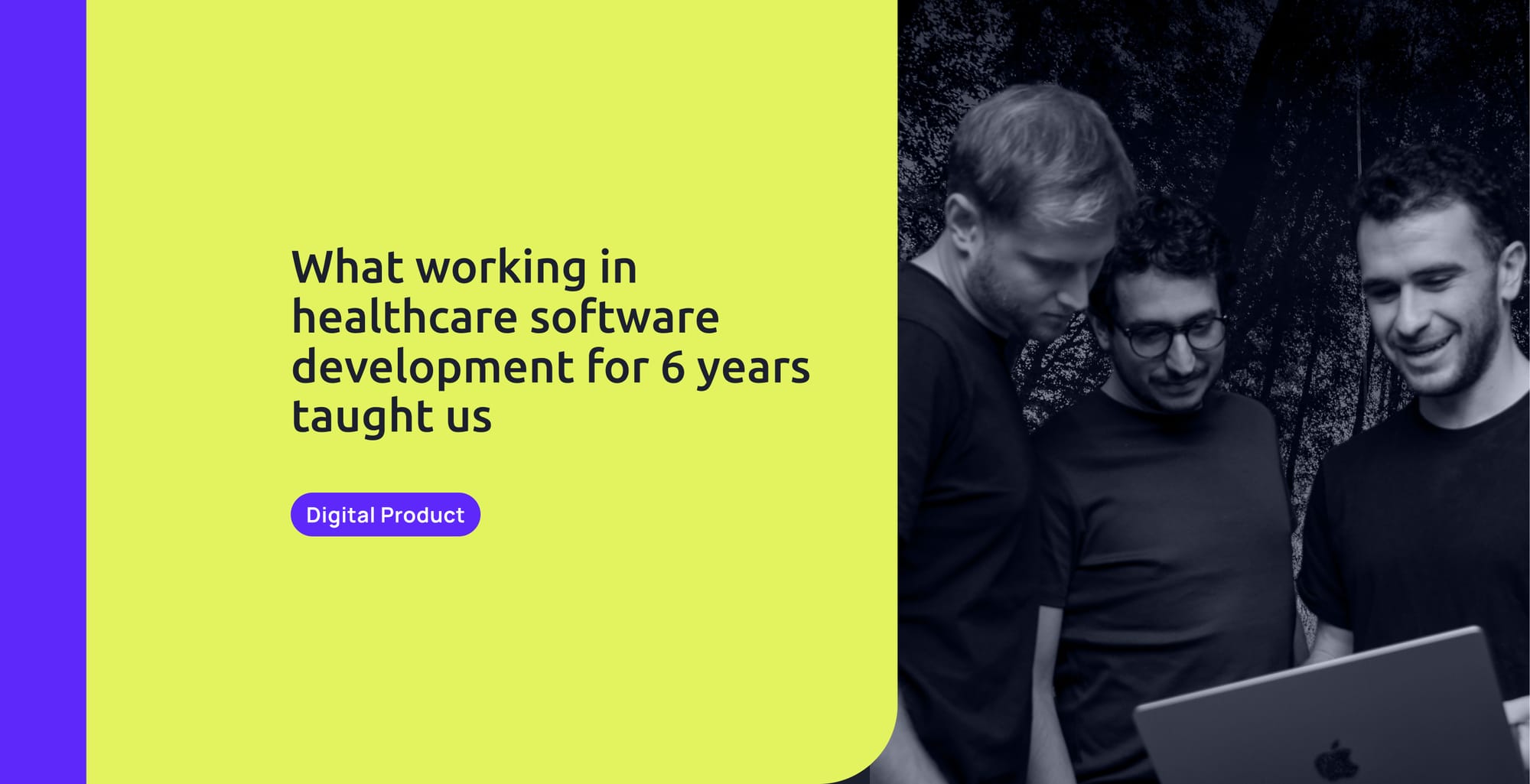If you’ve worked in healthcare software development, you already know: it’s not like other industries. It’s personal, it’s about people and care. It’s overloaded with legacy systems, worn-out staff, and patients who deserve better. You're not just pushing features. You’re navigating compliance and challenging regulations, emotionally charged environments, and deeply human problems.
We’ve sat in on consultations, mapped workflows, listened to complaints, and celebrated wins alongside entrepreneurs, doctors, physicians, and patients alike. One thing is clear: you can’t build for healthcare unless you truly understand it.
After six years of building inside this space, partnering with providers, payers, and digital healthcare companies, we’ve learned some hard, humbling lessons. Not just about healthcare, but about what it means to build software that actually works when people’s health is on the line.
These are our top lessons!
- Why "Just Updating" Isn’t an Option in Healthcare Software: A lesson by our Tech Manager Uriel Radzyminski
- QA Is Not a Phase, It’s a Mindset: A lesson by our Head of QA Matias Pirez
- Compliance Isn’t the Same as Security: A lesson by our Head of DevSecOps Juan Pablo Rodriguez Sotto
- When designing, the devil is in the details: A lesson by our Head of Design UX/UI Leila Tocci
- The best product ideas don’t come from assumptions; they come from observation: A lesson by our Head of Product development, Sofía Tucci
- If you're in healthtech, you’re in healthcare first. Tech second: A lesson by our Head of Delivery, Paula Pereira
Why "Just Updating" Isn’t an Option in Healthcare Software: A lesson by our Tech Manager, Uriel Radzyminski
Healthcare Software development demands more than clean code and clever architecture, it requires resilience and realism. We've learned this the hard way, building systems that operate under tight constraints, strict regulations, and real-world clinical pressures. Instead of fighting those constraints, we’ve learned to work with them, to build HIPAA-compliant, fault-tolerant systems that just can’t afford to fail.
That mindset led us to one of our most important lessons: immutability as a design principle.
That mindset led us to one of our most important lessons: immutability as a design principle.
In most software, editing a record means replacing it. But in healthcare, we realized that this approach is risky. Every piece of patient data, like diagnosis, lab results, or treatment decisions, must be preserved. Not just for compliance, but for clinical safety. Ideally, physicians and regulators should be able to know exactly what changed, when, by whom, and why.
So we stopped thinking in terms of updates. Now, every change is a new version. The previous data is never erased; it's layered beneath, like strata in an archaeological dig. This append-only model gives us a built-in audit trail, simplifies state tracking, and lets us reconstruct a patient’s full history at any point in time.
Once implemented, this approach made our systems far more predictable, traceable, and safe, as everything a healthcare product must be
QA Is Not a Phase, It’s a Mindset: A lesson by our Head of QA, Matias Pirez
The biggest lesson we’ve learned about Quality Assurance in healthcare? Quality isn’t a box to check at the end; it’s a principle that must be embedded from day one.
In healthcare, QA isn't just about avoiding bugs. It’s about protecting patients, earning trust, and building systems that hold up under pressure. That’s why for us, quality is a core development strategy, not an afterthought.
Here’s why it matters:
- Patient Safety Is Non-Negotiable
When healthcare software fails, people don’t just lose time; they can lose access to care, critical diagnoses, or even their lives. Every missed alert or misreported value can erode trust or cause harm. QA is how we prevent that. - It’s a Structural Backbone
For teams like ours, QA is part of the architecture. It's how we build secure, compliant, and reliable products that meet real-world clinical standards. HIPAA compliance and risk mitigation aren’t optional, they’re baked in from the start. - It Accelerates the Right Way
A strong QA culture helps teams move faster without cutting corners. It reduces rework, avoids regulatory surprises, and ensures clinicians, patients, and administrators get the experience they need, without compromise. - It's Continuous, Not Sequential
From discovery and pre-sales to production and post-launch, QA is everywhere. That means integrating validation, automated testing, and compliance checks early and revisiting them often. It’s how we build confidence at every step.
Compliance Isn’t the Same as Security: A lesson by our Head of DevSecOps, Juan Pablo Rodriguez Sotto
In healthcare, passing audits can create a dangerous illusion of safety. Regulatory standards like HIPAA define a baseline, but they don’t guarantee that a system is resilient in the real world. Attackers and even well-meaning users often exploit what's not explicitly covered: misconfigured access controls, exposed metadata, or assumptions about how people will behave. True security means preparing for the unexpected, like failure modes, odd user behavior, and scenarios no audit checklist will ever cover.
But secure systems aren’t built by one team; they’re a collective effort. We’ve made it a point to ensure that everyone involved in the product, from designers and developers to QAs and PMs, understands the critical role they play in security. We all have shared ownership to guarantee a project’s success: developers run static analysis tools as part of their workflows, QAs consider security implications in test cases, and product teams make risk-informed decisions, not just feature tradeoffs. After all, security is a core aspect of product quality and patient safety.
When designing, the devil is in the details: A lesson by our Head of Design UX/UI, Leila Tocci
Working in design for healthtech is inherently a team effort. In Light-it, this is how we approach things to provide the best results possible. One lesson to remember is to never underestimate attention to detail.
I recently asked our design team a simple question:
“What’s the hardest part of your job?”
And the answers we got painted a powerful picture of the challenges (and responsibility) that come with building digital experiences for people navigating their health.
Here’s what they shared:
1. Creativity is a Balance
Healthcare is one of the most heavily regulated industries out there. Every idea, every screen, every interaction must strike a balance between innovation and strict compliance. We’re constantly threading the needle, trying to push creative boundaries while upholding trust, privacy, and safety.
2. The Weight of Words
Sometimes, what we design has to deliver tough news. Other times, it’s nudging someone through a complex, bureaucratic task they’re dreading. The language we use matters. A lot. Behind every screen is a person who may be anxious, vulnerable, or overwhelmed. That’s why copywriting isn’t just a finishing touch; it’s a tool for empathy.
3. Account for Simplicity
Most people don’t open a healthcare app when everything is going great. They open it when something’s wrong. The healthcare industry is already overwhelming by nature, filled with stress, uncertainty, and information overload. Our goal is to offer an experience that feels like a helping hand, not another hurdle. In digital health, the best design is invisible; it simply gets out of the way. This helps with patient and provider adoption.
4. Designing for Everyone (Not Just the Easy Cases)
Even within the “niche” audiences we serve, there’s immense diversity of culture, ability, language, digital literacy, and access. Designing for one person shouldn’t mean excluding another. That’s why empathy can’t stop at the patient. We have to widen the lens to include caregivers, nurses, clinicians, insurers, and every person in the ecosystem.
In sum, details make or break healthtech products literally. Account for design in your business model and get ready for constant reviews and improvements.
The best product ideas don’t come from assumptions; they come from observation: A lesson by our Head of Product development, Sofía Tucci
We believe great product development starts with humility: a willingness to listen, to watch, and to question what we think we know. Guessing isn’t just inefficient, it’s irresponsible. That’s why our discovery process is a critical part of every project we take on. Whether it's remote or in-person, we invest the time to deeply understand your users, their workflows, their pain points, and their unspoken needs. This insight becomes the foundation of everything that follows.
By grounding our strategy in a real-world context, we’re building quickly and we’re building with purpose. It means fewer surprises down the road, faster paths to validation without compromising care or time to market, and ultimately, a product that fits naturally into the lives of those who use it.
If you're in healthtech, you’re in healthcare first. Tech second: A lesson by our Head of Delivery, Paula Pereira
Before I ever worked in tech, my world was measured in microliters. I spent years in labs, pipetting tiny volumes into plastic wells, spinning down tubes of blood, running assays under the cold glow of fluorescent lights. I held just about every type of patient sample you can imagine, each one a person’s story condensed into an unassuming vial.
This is about as far from the first line of care as you can get, and the stakes were still impossible to miss. On the other side of that sample was someone waiting for answers. I’d imagine their face without ever seeing it, feel their tension without ever meeting them.
That’s the perspective I brought when I moved into healthtech. And here’s what hit me fast: the stakes didn’t get lower. The real danger is that in tech, it’s easier to forget that on the other side of the code, is the same human story.
That’s why, if you think you’re just building software in healthtech, you’ve already missed the point. You’re in healthcare. Here, a missed alert isn’t a bug; it’s a missed diagnosis. A confusing form isn’t a UX flaw; it’s a barrier to treatment. And rushing a release before it’s truly ready? That’s playing roulette with someone’s health.
When deadlines loom or scope creeps, it’s tempting to think in terms of sprints, releases, and velocity. But in healthcare, that’s where delivery gets tricky, our role isn’t just to “get it built.” It’s to make sure what we build survives the pressure of real healthcare environments.
And chaos is the rule. The unpredictable reality of patient care means no plan survives first contact with the clinic floor. Messy workflows. Stressed staff. Urgent decisions. This is where our products have to perform, not in a controlled test environment, but in the middle of the storm.
I’ve seen that bridging the world of software delivery and the world of patient care takes more than project plans. It takes empathy to understand what’s on the line, resourcefulness to navigate the unknown, and an unshakable commitment to the people on the other side of the screen. Because in healthcare, “done” doesn’t mean passing QA, it means catching the things no one else can afford to drop.
And over time, this work rewires the way you think about technology. You start to see it as a constant balancing act to keep innovation and adaptability in harmony (not that those two words sound familiar or anything…). You’re chasing smarter systems, better ways to deliver care, solutions that have never existed before… while adapting to workflows shaped and battle-tested by decades of regulation, insurance bureaucracy, and real-world medicine.
So even when we aim for groundbreaking change, we may have to build technology that bends to healthcare’s reality, not the other way around. Because here’s the truth: a launch date means nothing if a nurse can’t find the patient’s chart in time. A flawless architecture means nothing if a provider can’t trust the data.
And that’s the heart of this lesson, in healthtech, the “tech” is only ever in service of the “health.”
Final Thoughts
As a nearshore software partner for U.S. health systems and healthtech startups, we’ve learned that launch day is just the start. The real work happens after, through adoption, iteration, training, and ongoing support. Every new feature changes someone’s workflow, and we take that responsibility seriously.
After six years focused solely on this space, we’ve made healthcare literacy a must across every role. We’ve delivered dozens of platforms that support care delivery, improve access, and reduce administrative burden because for us, purpose isn’t just a slide in the pitch deck. It’s visible in the process and the outcomes.
Healthcare software is having its moment. But building something with real impact takes more than good code. It takes knowing the regulations, the workflows, the pain points—and having a proven track record of getting it right. Technical chops are essential, but so is speaking the same language as your clinicians, administrators, and patients.
If you have doubts about how to choose your ideal healthcare software development partner, you should check out this post.
Whether you need HIPAA-compliant software, full-stack healthcare software development services, or a nearshore development team that works in your timezone and gets the domain, we’re here.


